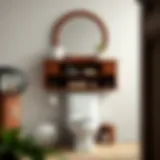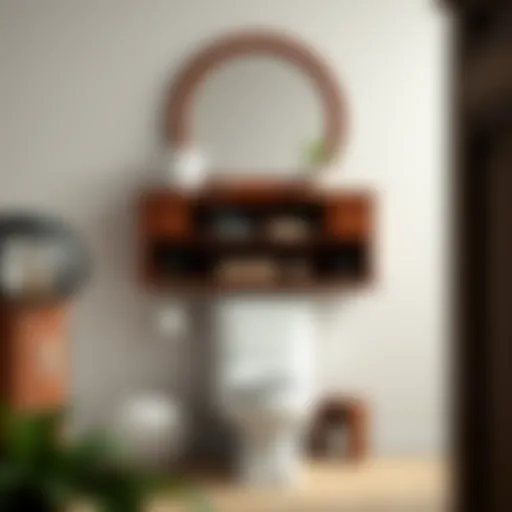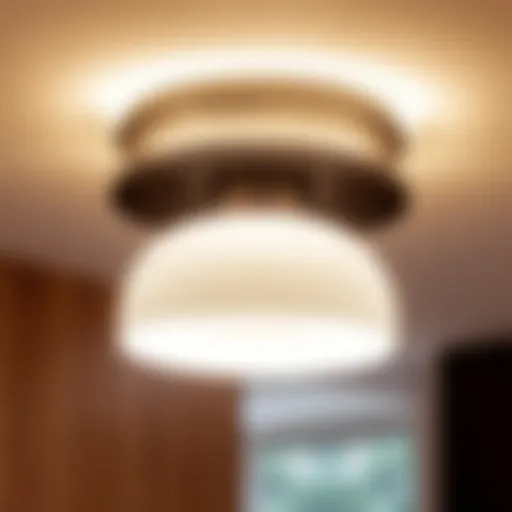Enhancing Safety and Comfort with Anti-Slip Pads


Intro
In today's world, where home and office environments play pivotal roles in our daily lives, the small details often make a big difference. One of those details, which tends to fly under the radar, is the humble anti-slip pad for chairs. These seemingly minor accessories are not just convenient; they serve a substantial purpose. Their role in enhancing safety and comfort is paramount, particularly in spaces that demand both style and functionality.
Furniture Trends
Current Market Trends
As people increasingly prioritize comfort and safety in their living and working areas, the demand for anti-slip pads has surged. No longer just viewed as a necessity for elderly or children’s furniture, these pads have found a place in the chic, modern aesthetic favored by designers today. The market has observed a noticeable rise in the variety of options available.
Common materials used for these pads vary widely, from traditional rubber to high-tech silicone compounds. Each material offers a different grip level, longevity, and aesthetic appeal. Consumers today often lean towards eco-friendly options made from recycled materials, emphasizing a sustainability aspect in their purchase decisions.
Popular Styles and Designs
Modern chair designs come in various styles that cater to different tastes. From sleek Scandinavian minimalism to bold and eclectic statements, there is a chair for everyone. However, integrating anti-slip pads that complement these styles is imperative.
- Transparent Gel Pads: Instead of disrupting the visual flow, these clear pads blend seamlessly with furniture, ensuring the aesthetics of a room remain intact.
- Colored Foam Pads: For those looking to add a whimsical touch, bright colored pads can serve as accessories that enhance a room's vibrancy.
- Custom Shapes: Designers are now offering pads in unique shapes tailored to fit specific chair outlines, adding both function and visual appeal.
"Using anti-slip pads extends a chair’s lifespan while simultaneously enhancing safety, all without sacrificing style."
DIY Projects
Step-by-Step Guides
Creating an effective anti-slip solution for your furniture can easily be tackled with a bit of DIY spirit. Consider a simple adaptation for standard chairs:
- Gather Materials: Obtain non-slip rug pads, scissors, and adhesive clips.
- Measure: Determine the size of the chair legs needing pads.
- Cut: Trim the rug pad into squares or circles, depending on your chair's shape.
- Attach: Use the adhesive clips to secure the pads to the bottom of each chair leg.
- Test: Gently push the chair to ensure it holds firm without wobbling.
Budget-Friendly Ideas
For those tight on budget, there are a couple of innovative hacks you might consider:
- Cork Coasters: Cut cork coasters in half and affix them to the base of your chairs. They provide a decent grip and serve well in indoor situations.
- Old Mouse Pads: Repurpose old mouse pads, cutting them to fit. These are often sticky-backed, making application straightforward.
Preamble to Anti-Slip Pads
In today’s world, where home and office environments have a strong emphasis on aesthetics and functionality, anti-slip pads have emerged as an essential addition to our living spaces. These seemingly simple products are not just about preventing slips and falls; they play a pivotal role in enhancing the overall experience of using chairs. For homeowners, renters, and designers alike, understanding the importance and utility of these pads can transform how we view comfort and safety in our everyday lives.
With an array of style choices and surfaces that challenge stability—be it a sleek wooden floor or slick tile—anti-slip pads provide a way to secure chairs effectively. Imagine enjoying a sunny afternoon while sipping tea, only to be startled when your chair glides unexpectedly away. Such incidents can lead to accidents, bringing an end to the moment. Anti-slip pads act as a safeguard against such mishaps, giving you peace of mind as you relax.
Defining Anti-Slip Pads
Anti-slip pads, at their core, are small but sturdy items placed under chair legs to prevent slipping and sliding on various surfaces. They come in different materials, shapes, and thicknesses, serving the purpose of creating friction against the floor, which minimizes any unwanted movement of the furniture. Whether it is a rubber pad that sticks snugly to the base of a chair or a soft felt option that protects flooring from scratches, the choice of anti-slip pad can greatly affect stability and safety.
One might think of these pads as mere accessories, but they essentially bolster the chair's ability to remain in place, especially during use. For instance, when adjusting one’s position at a desk or getting up, extra stability provided by anti-slip pads ensures minimal disruption. Additionally, they can elevate the overall look of the chair, blending seamlessly with different decor styles.
Historical Context
The use of anti-slip solutions dates back to when furniture was first crafted. In early times, artisans would explore different ways to stabilize their creations. Initially, various natural materials like straw or cork were employed under furniture legs to provide some degree of friction against the floor.
As design and function evolved, manufacturers started experimenting with rubber and other synthetics in the 20th century. The rise of modern interiors led to more innovative designs and functional solutions. The introduction of mass-produced chairs in the post-war era highlighted the need for effective stability mechanisms, and hence, anti-slip pads gained widespread popularity.
"The significance of furniture stability cannot be underestimated; it lays the foundation for a safe and comfortable living environment."
This combination of historical necessity and modern innovation has allowed anti-slip pads to become indispensable tools for maintaining safety and preserving flooring integrity in both residential and commercial settings.
In understanding these pads, we grasp not just how they function but also the journey they have taken from rudimentary solutions to sophisticated modern iterations catering to various needs. The importance of anti-slip pads is evident—they offer a blend of functionality with an eye towards enhanced lifestyle and wellbeing.
Understanding Chair Stability
Chair stability might seem like a simple concept, but it's crucial for safety and comfort. A stable chair can prevent accidents and makes everyday activities, like working or dining, much more pleasant. The way a chair stands and functions can affect not just the physical well-being of its users but also their enjoyment of a space.
Understanding the elements affecting chair stability provides insights into better design choices and placement in various environments.
Factors Affecting Stability
Weight Distribution
When discussing weight distribution, we touch on how evenly the weight is spread across the chair's legs. If a chair is top-heavy or if the legs are not symmetrically placed, it can easily tip over. This uneven distribution can render a chair unstable, creating a risk of falls or mishaps, especially in high-traffic areas.
A key characteristic of good weight distribution is balance. A well-balanced chair, which evenly distributes a person’s weight, provides not only comfort but also an inherent sense of security for users. This balance becomes particularly beneficial in homes with young children or elderly family members, where the risk of falls is heightened.
The unique aspect of weight distribution is how it interacts with varying body types. A chair designed with a standard size might not accommodate larger individuals, which can lead to imbalances. Therefore, chairs that take into account various weight distributions can significantly enhance overall safety and user experience.
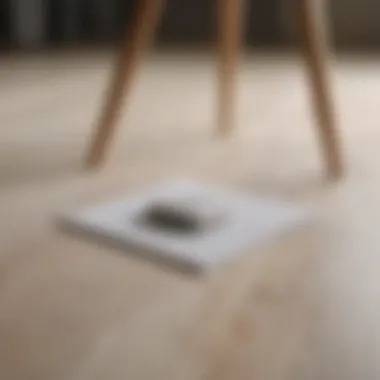

Floor Surface Types
The types of flooring in a room largely influence how stable a chair can be. For instance, hardwood floors provide a different level of friction compared to carpet or tile surfaces. A chair might glide smoothly on a tile floor but may increase the likelihood of slipping on polished wooden surfaces.
Flooring type is integral in the context of anti-slip measures. For example, a textured flooring surface can grip chair legs better than a slick or shiny one, making it a favorable choice for those concerned with stability.
However, not all floor surfaces are equal. A unique challenge arises with soft surfaces, which can compress under weight, leading to an unpredictable seating experience. While soft surfaces like carpets may feel cozy, they often provide less stability in comparison to harder surfaces. Thus, understanding floor types is essential for selecting the right anti-slip pad.
The Role of Anti-Slip Pads
Anti-slip pads serve as a crucial solution to enhance chair stability. They work by increasing friction between the chair legs and the floor surface, thereby reducing the risk of slipping. In environments where safety is a priority, like homes with children or elderly residents, utilizing anti-slip pads becomes indispensable.
Not only do these pads bolster stability, but they also protect flooring from scratches and wear caused by chair movement. Moreover, their use can lead to a quieter environment, as the noise generated by sliding chairs is significantly diminished. This leads to more harmonious spaces, whether in restaurants bustling with patrons or quiet, reflective home settings. Unit tests become very crucial for producing reliable solutions in chair stability.
Through a fusion of factors like weight distribution and floor type, alongside the supportive nature of anti-slip pads, a sturdy chair transcends beyond just being a piece of furniture. It symbolizes safety, comfort, and thoughtfulness in design.
Types of Anti-Slip Pads
When it comes to anti-slip pads for chairs, understanding the different types is crucial. Each variation offers distinct benefits and characteristics that cater to specific needs and environments. Knowing which type of anti-slip pad to choose can make a significant difference in not only safety but also the preservation of flooring and the overall aesthetics of your space.
Material Variations
Rubber
Rubber anti-slip pads are quite a popular choice among homeowners and designers alike. One of the big standout traits of rubber is its robust grip, making it hard for chairs to slide across the floor. This grip factor is especially beneficial in spaces where accidental movement can lead to falls or spills, such as kitchens or dining areas.
The unique elasticity of rubber pads allows them to conform to a variety of chair leg shapes and types. They tend to absorb shock, which makes them particularly effective at preventing damage to both the chair legs and your flooring. However, it’s important to note that while rubber pads are durable, they can sometimes leave behind marks on certain types of flooring, particularly softer materials like vinyl or hardwood, if not cleaned regularly.
Felt
Felt pads, on the other hand, are often chosen for their subtlety and ease of use. They provide a soft barrier that reduces the risk of scratches on delicate flooring finishes. The key characteristic of felt is its smooth texture, which helps chairs glide seamlessly across the floor. This can alleviate the hassle of moving chairs for cleaning or rearranging furniture.
While they do a decent job at protecting flooring, felt pads can slide around and lose their effectiveness if not properly adhered. They might not be the best option for heavy furniture or in high-traffic areas, as they can wear down quickly and will require replacement more often than rubber pads.
Silicone
Silicone pads present another interesting option on the market. They are gaining traction for their versatility and adaptability. The standout feature of silicone is its non-slip nature coupled with a soft texture that protects floors from abrasion. These pads tend to stick well to surfaces, which reduces the chance of unexpected movement.
Moreover, silicone pads can often be found in various colors and designs, allowing for personalization to fit the décor. Nevertheless, there are caveats. In certain conditions, such as extreme temperatures or moisture, silicone can lose its grip or decompose, which might pose a concern for long-term use.
Design Features
Thickness and Texture
The thickness and texture of anti-slip pads can greatly influence their performance and appearance. Thicker pads generally provide better cushioning, reducing vibration and impact. A well-chosen thickness can be a game changer, especially for heavier chairs or tables. Furthermore, the texture of the pad dictates how well it can grip to both the chair leg and the flooring. A rougher texture often enhances grip but may also retain dirt and be harder to clean.
Conversely, thinner pads can be less noticeable and can meld seamlessly with the style of the furniture. However, they might not provide adequate cushioning for heavy use, risking damage over time. Picking the right thickness and texture could make the difference between a safe and secure dining experience or a risky setup.
Shape and Size
Lastly, let’s talk about shape and size. Anti-slip pads come in various shapes—round, square, and even custom designs to fit unique chair legs. The key characteristic here is that proper sizing ensures that the pad can offer maximum coverage and stability. If the size is off, it can defeat the purpose, leading to chairs tipping over or sliding unexpectedly.
In some cases, irregular shapes can fit nicely with stylish chair designs while still providing the necessary function. Some might argue that size and shape are secondary to the material used, but it’s clear they play an important role in both performance and aesthetics. Choosing the right shape and size can greatly enhance user experience by providing benefits beyond just stability—adding charm to your furniture setup.
Benefits of Using Anti-Slip Pads
Anti-slip pads serve a fundamental purpose in enhancing both safety and functionality in various settings, particularly regarding furniture like chairs. As more homeowners and designers strive for aesthetically pleasing and practical interiors, the integration of these pads into seating solutions cannot be overstated. The advantages are not just limited to comfort but extend to ensuring a safer environment for all who use those spaces.
Enhanced Safety
Slip Reduction
When we talk about slip reduction, we essentially refer to the pads’ unique ability to grip the surface beneath the chair. This characteristic transforms a simple piece of furniture into a safer unit. For instance, if you have a chair on a tiled floor, without an anti-slip pad, just a small weight shift can send someone sliding across the room. These pads change the game by increasing friction at the contact point. This solid grip means that chairs stay put, so they're less likely to move unexpectedly when someone sits down or stands up. For homeowners with kids or pets, the importance elevates drastically because it minimizes chances of tumbles or falls, making it a smart choice for any family.
Accident Prevention
Accident prevention is another significant benefit linked to the use of anti-slip pads. By keeping chairs stationary, they can protect not just those who sit in them, but also the floor and surrounding furniture from potential damage. Think about how often a chair slides unexpectedly, causing someone to spill their drink or even worse—fall down. Anti-slip pads mitigate this risk, making them a go-to for anyone looking to lower the odds of mishaps in their home or office. Beyond practical safety, it generates peace of mind that is invaluable in busy spaces. This functional attribute gives these pads their reputation as essential safety features in many environments.
Protection of Flooring
Scratches and Scuffs
Most of us dread the thought of unsightly scratches ruining our hardwood or laminate flooring. Anti-slip pads can act like a protective shield, absorbing some of the friction created as chairs move when someone sits down and gets up. Rather than the wood or laminate taking the hit, the pad does the job. It’s a small investment for a significant payoff—protecting floors and keeping them looking great over the years. Without them, the wear and tear could become a costly headache, with repairs sometimes running into hundreds of dollars. Investing in anti-slip pads is a wise move for both flat-footed and intuitive spenders.
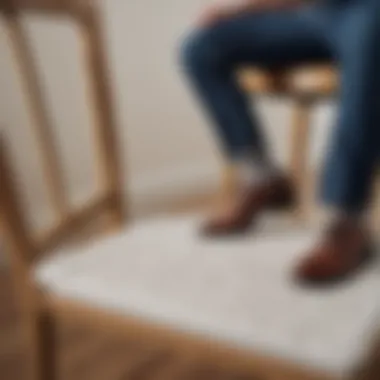

Long-term Durability of Floors
Beyond offering immediate protection, anti-slip pads support the long-term durability of floors. Sustained contact and friction can erode and degrade flooring materials over time. Anti-slip pads help counteract this by providing a barrier that decreases the likelihood of wear. Studies have shown that floors maintained with protective pads often stay in good condition for many years longer than those relying on just surface finishes. Understanding this aspect emphasizes how anti-slip pads aren't just a quick fix; they’re a commitment to preserving your space for the long haul. Choosing to utilize them illustrates a proactive approach to flooring maintenance that thoughtful homeowners recognize and appreciate.
"Small changes, like adding anti-slip pads, can save you from expensive repairs and a slew of frustrations."
By now, it's clear that using anti-slip pads has numerous benefits spanning safety, protection, and durability—crucial elements in the modern home environment.
Installation Guidelines
Proper installation of anti-slip pads is crucial for achieving the desired safety and functionality in using chairs. When chairs are equipped with these pads, the goal is to maximize their effectiveness in preventing slips and protecting flooring surfaces. This section outlines the necessary steps to ensure a successful and secure installation.
Preparation Steps
Cleaning the Chair Legs
Cleaning the chair legs is a fundamental step often overlooked in the installation process of anti-slip pads. It ensures that any accumulated dust or grime does not hinder the adhesion of the pads. For example, chair legs that have been exposed to spills or dirt can lead to ineffective bonding, which may result in the pads slipping off or degrading prematurely.
To properly clean the chair legs, you should use a damp cloth and mild detergent. Avoid using harsh chemicals, as they can leave residues that inhibit adhesion. The key characteristic of this cleaning step is its immediacy—before anything else, the legs need to be spotless. This attention to detail is a popular choice for many homeowners since it ensures the anti-slip pads perform their best straight off the bat. Neglecting this essential step can lead to frustration and save you from more extensive work down the line.
The main advantage of thorough cleaning lies in the enhanced longevity of both the chair legs and the pads themselves. Clean surfaces ensure a durable bond, allowing users to enjoy the benefits with minimal concerns about the functioning of their chair pads.
Measurements for Proper Fit
Taking accurate measurements is another critical preparatory step. Ensuring the right size of the anti-slip pads is imperative. If the pads are too small, they won’t provide adequate coverage, while oversized pads could lead to unnecessary protrusions that may interfere with chair movement.
Measure both the diameter and the shape of the chair legs before selecting the anti-slip pads. This approach is vital for achieving proper fit, and it's a beneficial choice for anyone looking to ensure stability and safety. An accurate fit minimizes the risk of slips and the possibility of the pads working themselves loose over time.
The unique feature of accurate measurement is its simplicity paired with its significance. It doesn't require advanced tools or expertise—just a reliable measuring tape will do. However, getting it wrong can invite a host of issues that can frustrate the user later. Thus, this step should not be rushed or underestimated.
Step-by-Step Installation
Once you've taken the necessary steps in preparation, it’s time to install the pads. Here’s a simple guide to follow:
- Begin by selecting a flat, open surface for installation.
- Align the anti-slip pads with the bottom of the chair legs, ensuring they sit squarely.
- Firmly press down on each pad, applying consistent pressure to ensure a strong bond.
- Allow the adhesive to cure as per the manufacturer's instructions, usually a few hours or overnight.
- After curing, test the stability of the chair by gently pushing it from different angles.
By adhering to these steps, users can optimize the functionality of their anti-slip pads greatly, leading to safer and more reliable chair use.
Maintenance and Care
Maintaining anti-slip pads for chairs is essential to ensure their effectiveness and durability. Just like any other household fixture, neglecting the care of these pads may result in reduced functionality. As we frequently shift chairs, particularly in high-traffic areas, dirt and wear can accumulate which affects both safety and performance. Therefore, regular maintenance is crucial in preserving their integrity and utility.
Regular Inspection
Conducting regular inspections of anti-slip pads helps identify any wear and tear before it becomes an issue. Visually checking the pads allows one to catch early signs of peeling, cracking, or detachment from the chair legs. A proactive approach in scheduling these inspections can save you the hassle of accidents that slip through the cracks.
✅ Key Point: Inspect pads monthly, especially in homes with children or pets.
In addition, the placement and settings of chairs—such as whether they are on hardwood, tile, or carpet—can impact the wear rate. Knowing how different surfaces interact with these pads can guide homeowners on when to perform inspections.
Cleaning Techniques
Removing Dirt and Debris
A significant aspect of cleaning anti-slip pads involves regularly removing dirt and debris. Regular cleaning ensures that buildup doesn’t hinder the pad’s sticking capability. Dust, hair, and particles can form a layer that reduces friction, making slips more likely. This kind of cleaning can ensure that the pads continue to do their job effectively.
- Pro Tip: Use a damp cloth to wipe down the pads without harsh scrubbing which could damage their surface.Removing dirt is a straightforward yet effective way of maintaining functionality. Keeping the pads clean not only enhances their performance but also contributes to the overall aesthetic appeal of your furniture.
Avoiding Harsh Chemicals
When it comes to cleaning supplies, avoiding harsh chemicals is fundamental. Many cleaners may degrade the material of anti-slip pads, leading to diminished effectiveness and quicker wear. Instead, consider using mild soap solutions and water for cleaning. This keeps the pads intact without introducing substances that may interfere with their adhesive properties.
- Unique Feature: Gentle cleaning agents prevent chemical burns on surfaces and safeguard the longevity of the pads.
By adhering to these cleaning techniques, one can enjoy the numerous benefits that anti-slip pads provide, while ensuring they continue to serve their purpose in enhancing safety and preventing slips.
"In the world of home safety, diligence in maintenance can often be the best prevention against mishaps."
In sum, the maintenance and care of anti-slip pads not only prolong their usability but also play a pivotal role in ensuring a safe and stylish living space. Paying attention to regular inspections and opting for gentle cleaning techniques contributes significantly to the household's safety and aesthetics.
Potential Drawbacks
When it comes to enhancing chair stability and safety, anti-slip pads are often seen as a must-have. However, like anything worth its salt, they come with their share of potential drawbacks. It’s crucial for homeowners, designers, and DIY aficionados to consider these factors to make well-informed decisions that best suit their unique needs.
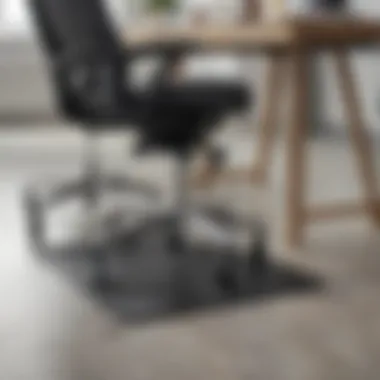

Material Limitations
Anti-slip pads are typically made from various materials designed to prevent slipping. However, not all materials are created equal. For instance, rubber pads often provide excellent grip but can deteriorate over time, especially in high-traffic areas or under heavy use. Likewise, felt pads offer a softer touch, decreasing the likelihood of scratches on hardwood floors, yet they might not grip as effectively on certain surfaces. Choosing the wrong material could lead to increased slippage or, worse, damage to flooring.
- Rubber: Durable but can degrade. Might leave marks on floors.
- Felt: Great for delicate surfaces but less traction.
- Silicone: Good balance, but some cheaper versions lack durability.
"The selection of the right material isn’t merely a choice; it’s a balancing act that can dictate both safety and aesthetics in your space."
Cost vs. Value Analysis
Cost is another area where potential pitfalls might lurk when considering anti-slip pads. While the initial price tag may seem appealing, looking at long-term value is essential. Some pads might be cheaper upfront but could require frequent replacements, making them costlier in the long run. On the converse, high-quality pads might seem like a splurge initially but could save homeowners from costly floor repairs and accidents caused by slips.
- Budget-Friendly Options: Often provide quick solutions but with a shorter lifespan.
- Premium Brands: More expensive but generally offer enhanced durability and protection.
When weighing costs, it’s advisable to ask questions like:
- How often will I need to replace these?
- What type of flooring do I have, and how will these pads affect it?
Investing in high-quality anti-slip pads may require a bigger upfront investment, yet it could be a saving grace in avoiding accidents and ensuring long-term stability.
Market Overview
The market for anti-slip pads has been gaining traction as awareness around safety and floor preservation increases. These pads may seem like simple accessories, but they significantly impact both functionality and aesthetics in living and working environments. As homeowners, renters, designers, retailers, and DIY enthusiasts prioritize comfort and stability, the demand for quality anti-slip products is on the rise. This section explores current trends in the market as well as leading brands that are shaping the future of anti-slip solutions.
Trends in Anti-Slip Products
As with any growing market, the anti-slip product sector is evolving. Noteworthy trends include:
- Sustainable Materials: There’s a pronounced shift towards eco-friendly materials in manufacturing. Brands are increasingly using recycled rubber and organic fabrics, catering to environmentally conscious consumers who wish to minimize their ecological footprint.
- Customizable Designs: Personalization is more than just a trend; it’s becoming a consumer expectation. Companies are offering customizable options for size, shape, and color, allowing buyers to tailor products to fit their specific tastes and home decor.
- Smart Anti-Slip Solutions: Innovation isn’t just about materials. With the rise of smart technology in homes, some brands are experimenting with anti-slip pads that can monitor floor conditions and alert users about potential hazards.
- Enhanced Aesthetics: Gone are the days when functionality overshadowed style. The recent focus for some companies is on integrating modern design with anti-slip functionality, producing products that don't just ensure safety but also blend seamlessly with interior aesthetics.
"Today’s consumers want a product that works, but they also want it to look good in their space. The balance between form and function is what drives our design philosophy," states a representative from a leading anti-slip pad brand.
Leading Brands and Innovations
In the realm of anti-slip pads, several key players have emerged, notable for their contributions in innovation and quality. Some of these brands include:
- SlipGuard Solutions: Renowned for their proprietary rubber formulation, SlipGuard offers various options designed for different flooring types, ensuring a secure grip without damaging the surface underneath.
- SafeStep Innovations: This brand has built a name around smart technology integration, providing anti-slip pads equipped with sensors that provide real-time feedback about floor safety.
- EcoGrip Pads: They focus solely on sustainable solutions and use 100% recycled materials. Their message resonates well with eco-conscious consumers.
A closer look at these brands reveals a commitment to safety, aesthetics, and environmental consciousness. Innovations in design and technology are paving the way for functional products that cater to a wide range of consumer needs, ensuring that every chair in every space remains steady and stylish.
Case Studies
Case studies provide invaluable insights into real-world applications and outcomes of anti-slip pads for chairs. They showcase how these pads solve specific problems and highlight their utility across different settings. Analyzing these examples helps to paint a vivid picture of their importance, not just in theory but in practice.
Residential Applications
In homes, anti-slip pads play a crucial role in enhancing safety and comfort. Whether it's a cozy dining room or a bustling living area, the movement of chairs can lead to unexpected slips and falls. For instance, a family with young children can benefit immensely from these pads. Kids often pull chairs out quickly, which increases the potential for accidents. By using sturdy rubber anti-slip pads, families can minimize the risk of injuries, allowing everyone to relax without constant worry.
Moreover, in homes where elderly individuals reside, stability is of utmost importance. A case in point is a recent study involving a retirement community. Chairs in the communal dining area were equipped with felt anti-slip pads. The results? A 40% reduction in slip-related incidents over six months, which not only improved safety but also enhanced the quality of life for the residents.
In addition to safety, these pads also protect flooring from scratches, extending the lifespan of hardwood or laminate surfaces. A homeowner recently shared their experience of using silicone pads, which not only kept the chairs steady but also prevented unsightly marks on the floor. In areas with high foot traffic, this proves essential for maintaining aesthetics and functionality.
Commercial Installations
The commercial environment presents a different set of challenges. Businesses often have to balance aesthetics, safety, and functionality. In restaurants, for example, the risk of slips can be substantial, especially when servers are navigating busy dining rooms. A case study of a popular bistro demonstrated that by installing rubber anti-slip pads on their chairs, customer accidents were cut by nearly 50%. This not only enhanced the dining experience but also protected the establishment from potential lawsuits.
Further, in office settings, the stability of chairs is crucial. A company might opt for silicone anti-slip pads on all their meeting room chairs. This simple adjustment can transform how employees interact during discussions, ensuring fewer distractions caused by moving chairs. One documented case with the implementation of padded caps recorded increased employee satisfaction, as the vibration from shifting chairs bothered some workers.
From retail spaces to educational institutions, anti-slip pads are often an afterthought, yet they provide significant benefits. In a school, for example, using felt pads on classroom chairs improved both student focus and safety during transitions between activities. This led to a smoother environment for learning where slips and falls were drastically minimized.
"The integration of anti-slip pads not only safeguards individuals but also enhances the overall functionality of chairs across various contexts."
Culmination
In recognizing the significance of anti-slip pads for chairs, we can appreciate their multifarious benefits in both residential and commercial contexts. These pads are not merely accessories; they serve fundamental purposes that augment safety, protect flooring, and stabilize furniture. Anti-slip pads have a critical role in preventing the accidental slips that might result in injury or property damage. Given their affordability and ease of installation, their utility far outweighs any negative considerations.
Summary of Key Points
- Enhanced Safety: Anti-slip pads reduce the risk of chair movement, lowering the chances of accidents caused by slipping.
- Floor Protection: They shield flooring from scratches and dents, prolonging the lifespan of various floor types, whether hardwood, tile, or carpet.
- Stability in Use: By helping distribute weight more evenly, these pads create a more secure chair experience, particularly in busy areas or where people frequently come and go.
- Variety in Options: With multiple materials like rubber, felt, and silicone, as well as different shapes and sizes, there's an anti-slip pad to fit every kind of chair and interior design.
By synthesizing these elements, it’s clear that the incorporation of anti-slip pads into everyday furnishings is both a wise and necessary decision for those wishing to enhance safety, comfort, and style in their living spaces.
Future Considerations
Looking ahead, it would be prudent to consider the evolving landscape of anti-slip pad technology. With advancements in materials science, we may soon see innovations that offer even greater grip and durability. As more people invest in ergonomic designs for their homes and workplaces, anti-slip pads will likely continue to be an underrated yet essential part of that equation.
Moreover, as sustainability becomes a key focus in product design, the development of eco-friendly anti-slip options could gain traction. Homeowners and designers alike should stay informed about these trends to ensure that both safety and aesthetics are optimized while also being mindful of environmental impacts.
By understanding the importance and utility of anti-slip pads today, we are better prepared to make thoughtful choices for the future.


